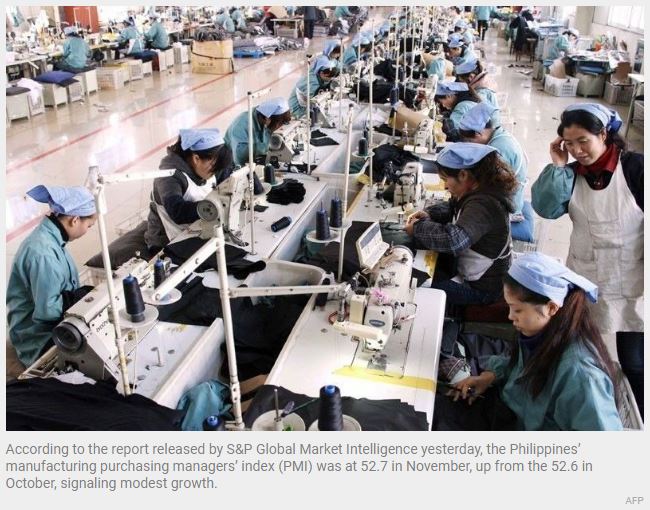Philippines: Factory activity perks up as demand improves in November
MANILA, Philippines — The country’s manufacturing activity picked up slightly in November from the previous month on improved demand conditions, but elevated prices continue to pose challenges for the sector.
According to the report released by S&P Global Market Intelligence yesterday, the Philippines’ manufacturing purchasing managers’ index (PMI) was at 52.7 in November, up from the 52.6 in October, signaling modest growth.
S&P Global said the latest PMI result showed an improvement in the health of the manufacturing sector as it remained above the 50-threshold for the 10th month. A reading above 50 indicates an overall increase, while below 50 denotes contraction.
The PMI, which is based on a survey covering around 400 manufacturers, tracks the performance of the manufacturing sector based on the following: new orders, output, employment, suppliers’ delivery times and stocks of purchases.
“The improvement across the sector primarily stemmed from greater demand conditions, which drove higher sales and output,” S&P Global Market Intelligence economist Maryam Baluch said.
With demand remaining strong midway through the fourth quarter, S&P Global said new orders and manufacturing output posted growth for the third straight month, with the rates of increase the fastest since June.
Demand was primarily driven by the domestic market, as new export orders continued to see a contraction observed since March due to weak foreign client appetite.
Compared to October, the contraction in export sales softened last month.
To support growth in sales and the expected increase in orders in the coming months, manufacturing firms increased their input purchases for the third consecutive month in November.
Surveyed firms reported improvements in production efficiency, but also said their workforce numbers were reduced, with resignations by employees as the commonly cited reason for the lower staff count.
“While the manufacturing sector has shown strong gains during 2022, elevated price pressures pose an ongoing threat,” Baluch said.
Manufacturing firms have blamed the higher energy costs for their increased expenses.
Faced with higher costs, firms chose to pass these to clients by raising their prices in November.
S&P Global said manufacturing firms also continue to face supply chain pressures.
While the incidence of delays was at a three-month low, it said port congestion and material shortages affected vendor performance.
“Coupled with supply chain issues, the peso weakening against the dollar adds further fragility,” Baluch said.
In its quest to curb inflation, the Bangko Sentral ng Pilipinas delivered a 75-basis-point rate hike last month, bringing the benchmark rate to a 14-year high of five percent.
“As the manufacturing sector has relied heavily on demand to help boost growth, the rise in rates, with the prospect of further potential monetary tightening, could impact consumer spending,” Baluch said.
Looking ahead, manufacturing firms remain optimistic, with nearly two-thirds expecting growth in output in the coming 12 months.
S&P Global said the positive outlook for the sector is based on greater client activity, opening of the economy, and new projects to be undertaken by firms.
Source: https://www.philstar.com/business/2022/12/02/2227873/factory-activity-perks-demand-improves-november


 English
English




